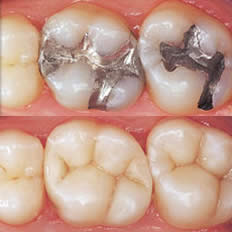Tooth Colored Fillings
 Tooth colored fillings are made of a composite resin and bonded to the tooth creating strength.You have many choices when it comes to restoring damaged or decayed teeth, even down to the type of dental filling material to use. You may choose to have white “tooth-colored” fillings (composite or porcelain) restorations.
Tooth colored fillings are made of a composite resin and bonded to the tooth creating strength.You have many choices when it comes to restoring damaged or decayed teeth, even down to the type of dental filling material to use. You may choose to have white “tooth-colored” fillings (composite or porcelain) restorations.
Furthermore, many people decide to replace their older silver amalgam fillings with newer white “tooth-colored” composite fillings. There are a number of pros and cons associated with both composite and amalgam fillings.
Safety and Appearance: In addition to having a more pleasing and natural tooth-like appearance, composite fillings have the potential advantage of not containing mercury or other metals that may contribute to sensitivity or toxicity. Mercury toxicity from amalgam fillings is a controversial subject, though no research to date has been able to show any risks of having mercury as a component of amalgam dental fillings. However, many patients do have metal sensitivities and some have reported a metal taste after the placement of amalgam fillings.
Durability: Composite fillings previously were not as durable as amalgams. However, dental manufacturers have made great strides in improving the strength of composite resin materials, to the effect that composite fillings now have the potential to be used for all teeth, including molars. Furthermore, composite materials often require less tooth preparation and may not weaken the affected tooth as much as amalgam fillings, which often require more extensive tooth preparation.
Tooth Shaping: Composite and amalgam fillings require preparation of the affected tooth, but less preparation is usually required for a composite filling. Typically, this means that less healthy tooth structure has to be removed when placing a composite.
Technique and Time: More than amalgam fillings, the success of composite fillings depends on your dentist’s technique. Composite filling restoration also requires the use of additional equipment, and the procedure itself requires up to 50% more time than the amalgam filling procedure. These factors contribute to the higher costs associated with composite fillings. In addition, most dental insurance companies do not cover the additional costs associated with composite fillings.
Skill: Most dentists are skilled in composite fillings, but their level of skill may vary. Selecting the appropriate dentist is an important factor in treating tooth decay or similar damage. Ask if your dentist has obtained the kind of post-graduate education that allows dentists to refine their skills in composite restorations.
If you spend some time understanding the differences between the various restorative procedures and the materials used for each, you will be better informed as to the option that works best for you. Consult with your dentist to determine the treatment time, cost, functionality and esthetic value of all available restorative treatments for decayed or damaged teeth.
Find out more by requesting an appointment or contact us today.






